
Great Junction Street is a street in Leith, on the northern outskirts of Edinburgh, Scotland. It runs southeast to northwest following approximately the southwestmost line of the old town walls around Leith.

Great Junction Street is a street in Leith, on the northern outskirts of Edinburgh, Scotland. It runs southeast to northwest following approximately the southwestmost line of the old town walls around Leith.

The road was planned c.1800 as a route to join the foot of Leith Walk with Ferry Road and the new wet docks bypassing the narrow and busy streets of old Leith. [1] The link was completed by the construction of Junction Bridge over the Water of Leith in 1818 although the road between the bridge and Bonnington Road was not surfaced until the late 1830s.
The street was the site of a triumphal arch which was constructed for the reception of Queen Victoria and Prince Albert in 1842. Great crowds attended this despite the heavy rain. Prince Albert added to the general merriment of the occasion by observing that he supposed that this was just a Scotch mist. [2]
People from Leith often refer to Great Junction Street as Junction Street. North Junction Street lies at its extreme west end. It is connected to the area known as the Shore via Henderson Street.
Although typified by tenements the tenements in their own right are not necessarily typical. Great Junction Street has an abnormal number of flat-roofed tenements. These survived the ravages of the Scottish weather due to their novel construction; three inches of horse hair and tar (strong, flexible and impervious). These roofs normally survive well until tackled by Housing Repair Grant projects, which invariably replace them with felt, not appreciating the durability and value of the original roof. [3]

Other buildings of note are the former Leith Provident Co-operative Society building with its octagonal clock tower with lead-covered domed roof and Ionic attached columns making it a local landmark. Built in 1911, the building is Category B listed by Historic Scotland. Also B listed, the attached building with ground floor shops also formerly occupied by Leith Provident was built in 1905. The central warehousing (east of Cables Wynd) was built originally as a wine vault overlooking fields to the south. It was bought by Crabbie's whisky, and served as a bonded warehouse for most of the 20th century, being greatly expanded on its west side. Crabbie's Green Ginger was made in a small modern building on the east side (now demolished). The warehouse also served to mature many of the famous whiskies, which largely came to Leith to mature. This building was internally labelled in rows for Talisker, Laphroaig and so on. Following sale to United Distillers it was closed down and has now been converted to flats.
On the south side of the road, Junction Place, shows where a collection of public buildings formerly stood. "Fire Engine House", stepping into the street midway, was a horse-drawn fire service, the gates opening onto the narrowest part of the roadway. At the very end of Junction Place stood Leith Electricity Generating Station, a surprisingly domestic scale building erected in 1895 to provide electric street lights, but having a bronze plaque to explain its creation. [4] On the west side Dr Bell's School designed by R & R Dickson [5] in 1839 operated the Madras System of Education. Behind it, Leith Swimming Baths (now restored) linked to the Public Baths (i.e. rows of enamel baths) and Laundry (both later demolished to create the Victoria Swim Centre in 1899). [6] The baths were in use until the late 1970s, due to the high number of Leith dwellings lacking bathrooms up to that time.
In 2002 the very unusual but very out of character Telectra House was demolished and replaced with housing. This had been built (between Cables Wynd and King Street) in the early 1960s as a department store extension to the existing Leith Provident Co-operative Society building. Despite a late call to list the building as a monument to Modern Architecture this was blocked due to high asbestos content in the building. [7]
A plaque on the corner of King Street marks it as the now demolished birthplace of Sir John Gladstone of Fasque, father of William Gladstone the future Prime Minister of Britain.
King Street leads through to the eastern sections of Leith Hospital: the cholera isolation block and nurses home on the east, the Queen Victoria Diamond Jubilee block on the west.
The former State Cinema by James Miller & Partners stands at the extreme west end of the street adjacent to the Water of Leith. The building dates from 1938 but spent most of the latter part of the 20th century as a bingo hall. It currently houses the Kingdom Church and the Sketchy Beats concept cafe. [8]
Taylor Gardens is the small pocket park at the west end of Great Junction Street.
It was formed in 1920, following the demolition of South Leith Poorhouse. Unusually for the period, that was not the end of Leith's poorhouse: a new poorhouse was built at Seafield in 1923, converted to a military hospital in 1939, then a normal hospital, the Eastern General, in 1946. It in turn was demolished in 2008.


The Taylor Gardens park was created as a setting as part of a project to expand Leith Hospital, immediately to the north. In an Act of 1919 all local authorities were obliged to erect war memorials. There were strict guidelines on their form. Leith appealed to the authorities to request that a new wing be built on the hospital instead; specifically a children's wing. This was agreed, but clearly cost a lot more in terms of public subscription. The wing, which faces Taylor Gardens, therefore reads "Leith War Memorial" along the top, with various military badges and emblems also carved. Since the hospital's conversion to housing in the early 21st century, a new plinth has been erected in Taylor Gardens in order to lay wreaths on Remembrance Day.
On the north-west side of the gardens (on Mill Lane) stands a two-storey building dating from 1822. This was built as a school for the poorhouse, with boys on one floor and girls on the other. This was the first free education provided to females in this area. It was replaced by a new pair of schools (one for girls one for boys) further along Mill Lane, in 1838. These were built by Sir John Gladstone of Leith, William Gladstone's father. This connection led to the first-mentioned ex-school being named "Gladstones".
Opposite Taylor Gardens is an area of Scottish Special Housing Association (SSHA) housing erected in 1981. This replaced an area cleared as slum housing as part of a Comprehensive Redevelopment Area designated by the Council.
The north-east corner has a plaque to the Siege of Leith in 1561.
The enamel street number plates were created by students at Edinburgh College of Art as part of a practical design exercise.
The Ebenezer Church formerly in the centre of the street frontage was demolished but rebuilt as a new church on Bangor Road.

Leith is a port area in the north of the city of Edinburgh, Scotland, founded at the mouth of the Water of Leith.
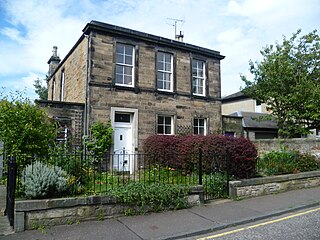
Sciennes is a district of Edinburgh, Scotland, situated approximately 2 kilometres south of the city centre. It is a mainly residential district, although it is also well-known as the site of the former Royal Hospital for Sick Children. Most of its housing stock consists of terraces of four-storey Victorian tenements. The district is popular with students, thanks to its proximity to the University of Edinburgh. Its early history is linked to the presence in the area of the 16th-century Convent of St Catherine of Scienna, from which the district derives its name.
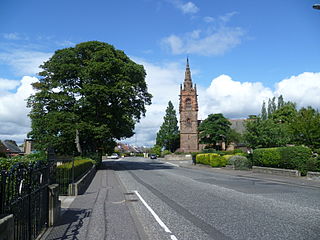
Craiglockhart is a suburb in the south west of Edinburgh, Scotland, lying between Colinton to the south, Morningside to the east Merchiston to the north east, and Longstone and Kingsknowe to the west. The Water of Leith is also to the west.

This article is a timeline of the history of Edinburgh, Scotland, up to the present day. It traces its rise from an early hill fort and later royal residence to the bustling city and capital of Scotland that it is today.
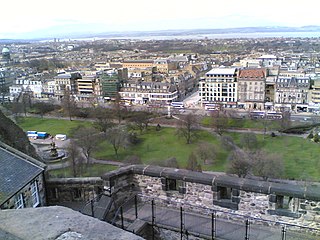
The New Town is a central area of Edinburgh, the capital of Scotland. It was built in stages between 1767 and around 1850, and retains much of its original neo-classical and Georgian period architecture. Its best known street is Princes Street, facing Edinburgh Castle and the Old Town across the geological depression of the former Nor Loch. Together with the West End, the New Town was designated a UNESCO World Heritage Site alongside the Old Town in 1995. The area is also famed for the New Town Gardens, a heritage designation since March 2001.
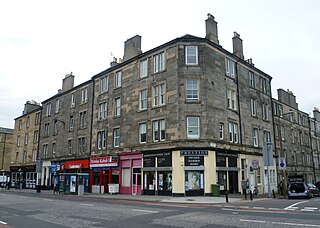
Dalry is an area of the Scottish capital city of Edinburgh. It is located close to the city centre, between Haymarket and Gorgie. The area is now primarily residential. It is centred around Dalry Road, which has numerous shops, restaurants and small businesses. Lying outside the old city walls and west of the castle, the area began as part of the agricultural estate of Dalry House, the exception being the Dalry Mill, recorded as the oldest paper mill in Scotland, now demolished.

Bonnington is a district of Edinburgh, the capital of Scotland. The area centres upon an original village which grew up around a ford on the Water of Leith on the old boundary between Edinburgh and the port of Leith. Before the creation of Leith Walk the road via the villages of Broughton and Bonnington, or Wester Road as it appears on some old maps, was one of two roads formerly connecting Edinburgh to Leith; the other being Easter Road. The district lies between the districts of Pilrig and Newhaven.
Easter Road is an arterial road in north Edinburgh, the capital of Scotland. The road is so called as it was known as the "Easter (eastern) road to Leith". As maps of Edinburgh in the late 18th century show, it had a counterpart in "Wester Road". Until the creation of Leith Walk in the middle of the 17th century these were the two main routes from Leith to Edinburgh. Historic personages who have ridden up Easter Road have included Mary, Queen of Scots (1561) and Oliver Cromwell.

Leith Walk is one of the longest streets in Edinburgh, Scotland, and is the main road connecting the centre of the city to Leith. Forming most of the A900 road, it slopes downwards from Picardy Place at the south-western end of the street to the 'Foot of the Walk' at the north-eastern end, where Great Junction Street, Duke Street, Constitution Street and the Kirkgate meet.

There have been several town walls around Edinburgh, Scotland, since the 12th century. Some form of wall probably existed from the foundation of the royal burgh in around 1125, though the first building is recorded in the mid-15th century, when the King's Wall was constructed. In the 16th century the more extensive Flodden Wall was erected, following the Scots' defeat at the Battle of Flodden in 1513. This was extended by the Telfer Wall in the early 17th century. The walls had a number of gates, known as ports, the most important being the Netherbow Port, which stood halfway down the Royal Mile. This gave access from the Canongate which was, at that time, a separate burgh.
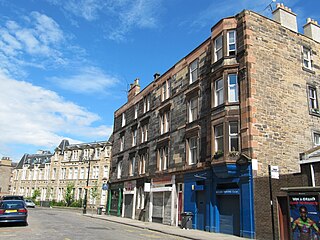
Henderson Street is a street in Leith, a district of the city of Edinburgh, Scotland. It forms a curving artery between Great Junction Street and an area known as the Shore, where the Water of Leith runs into the Port of Leith/Leith Docks. Henderson Street lies within the boundaries of the Leith Conservation Area and includes several listed buildings.
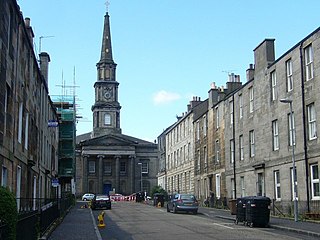
North Leith Parish Church is a congregation of the Church of Scotland, within the Presbytery of Edinburgh. It is serves part of Leith, formerly an independent burgh and since 1920 a part of the city of Edinburgh, Scotland.
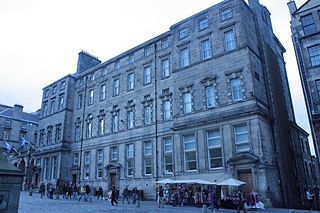
Ebenezer James MacRae was a Scottish architect serving as City Architect for Edinburgh for most of his active life.
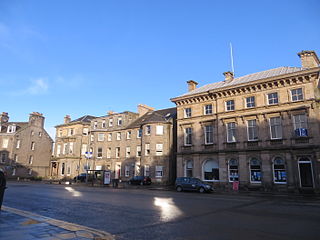
Bernard Street is a thoroughfare in Leith, Edinburgh, Scotland. It runs west north westerly from the junction of Constitution Street and Baltic Street to meet the Water of Leith at The Shore. It forms the northern boundary of what was known in the 19th century as 'Old Leith'.
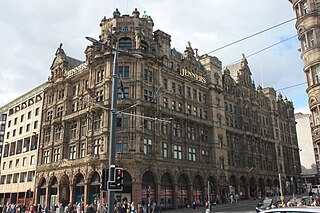
William Hamilton Beattie was a Scottish architect specialising in hotel design in the late 19th century.

Richard and Robert Dickson were brothers, acting as architects in Scotland in the early and mid-19th century. Whilst most of their work is typified by remote country houses they are best known for their magnificent spire on the Tron Kirk in the heart of Edinburgh on the Royal Mile.

Charles George Hood Kinnear FRIBA ARSA FRSE was one half of Peddie & Kinnear partnership, one of Scotland’s most renowned and prodigious architectural firms, famed for their development of the Scots Baronial style, typified by Cockburn Street in Edinburgh which evokes a highly medieval atmosphere. Kinnear was also a pioneer photographer credited with inventing the bellows attachment on early cameras.
George Craig JP EGS (1852-1927) was a Scottish architect and amateur geologist. He created a very high proportion of the 19th century public buildings in Leith.

Kirkgate is an ancient thoroughfare in Leith, Edinburgh, Scotland. It runs north from the foot of Leith Walk towards Leith Docks. It is one of the oldest streets in the district and historically one of its most vital road links.

James Simpson (1830–1894) was a 19th century Scottish architect. He is particularly associated with Leith. He served as the Burgh Assessor and Town Architect of Leith and created and oversaw the Leith Improvement Plan of 1888.